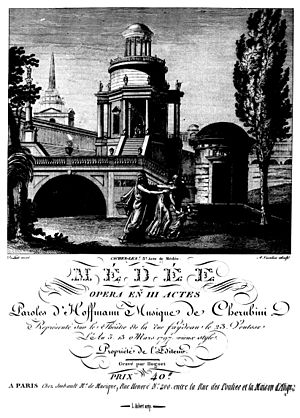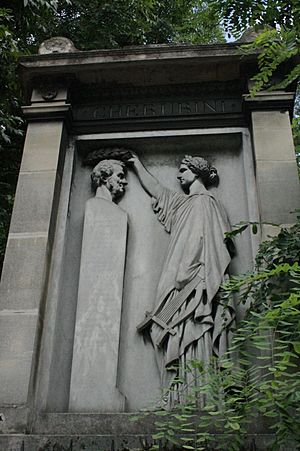Luigi Cherubini facts for kids
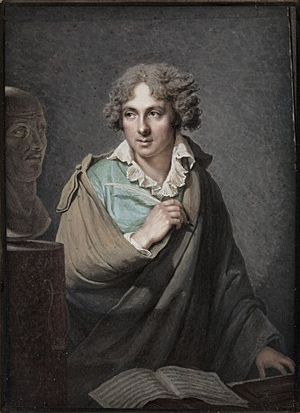
Luigi Cherubini was an Italian composer who lived from 1760 to 1842. He wrote music during the Classical and Romantic periods. He is best known for his operas (musical plays) and sacred music (music for church). Even famous composers like Beethoven and Rossini thought he was one of the best composers of his time.
Contents
Early Life and Musical Start
Luigi Cherubini was born in Florence, Italy, in 1760. His full name was Maria Luigi Carlo Zenobio Salvatore Cherubini. People are not completely sure if he was born on September 8th or 14th, but many believe it was the 8th.
He started learning music at age six from his father, Bartolomeo. His father was a "master of the harpsichord," which meant he led musical groups from the harpsichord. Luigi was considered a child prodigy because he was so talented at a young age. He learned complex music skills like counterpoint and how to write for the stage. By the time he was thirteen, he had already written several religious music pieces.
Growing Up and First Operas
In 1780, Luigi received a special scholarship from the Grand Duke of Tuscany. This allowed him to study music in Bologna and Milan. His early serious operas, called opere serie, followed the usual rules for plays at the time. His music was influenced by other leading Italian composers like Niccolò Jommelli and Antonio Sacchini.
In 1783, his first comic opera, Lo sposo di tre e marito di nessuna, was performed in Venice. Cherubini felt that Italian music traditions were too strict. He wanted to try new things. So, in 1785, he traveled to London, England. There, he wrote two serious operas and one comic opera for the King's Theatre.
That same year, he visited Paris, France, with his friend, the violinist Giovanni Battista Viotti. Viotti introduced him to important people, including Marie Antoinette. Cherubini then got a big job to write an opera called Démophoon with French words. This was his first French tragédie en musique (a type of French opera). After this, Cherubini spent most of his life in France. He only made short trips back to London and Turin for other opera projects.
Life in France and New Music
Cherubini started using the French version of his name: Marie-Louis-Charles-Zénobi-Salvador Cherubini. His opera Démophoon was well-received in Paris in 1788. With help from his friend Viotti, Cherubini became the director of the Théâtre de Monsieur in 1789. This theater later became the Théâtre Feydeau. Being a director allowed him to choose the stories he wanted to set to music.
Cherubini's music became more unique and daring during this time. His first big success was Lodoïska (1791), which people liked for its realistic heroes. Next came Elisa (1794), which was set in the Swiss Alps, and then Médée (1797). Médée is still his most famous work today. Another popular opera was Les deux journées (1800), where he used a simpler style. These operas were performed at the Théâtre Feydeau or the Opéra-Comique. Feeling secure financially, he married Anne Cécile Tourette in 1794, and they had three children.
The French Revolution (a big political change in France) affected Cherubini's life. He had to be careful about his past connections with the old French leaders and seek jobs from the new government. Even though Napoleon found his music a bit too complex, Cherubini wrote at least one patriotic piece of music every year for over ten years. He was even Napoleon's music director in Vienna for a while in 1805 and 1806, where he conducted his own works.
From Operas to Church Music
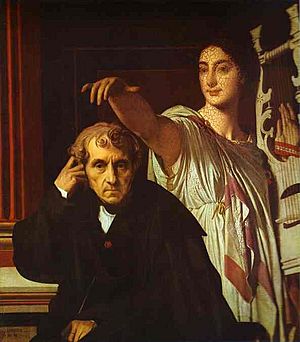
After Les deux journées, Parisian audiences started to prefer younger composers. Cherubini's opera-ballet Anacréon was not successful, and most of his stage works after that did not do well. However, his opera Faniska in 1806 was an exception. It was very popular, especially with composers like Haydn and Beethoven. His heroic drama Les Abencérages (1813) was an attempt to compete with another famous opera, but it had few performances despite good reviews.
Because he was not getting much praise for his operas, Cherubini started writing more church music. He composed seven masses, two requiems (music for the dead), and many shorter pieces. During this time, under the restored monarchy, he became the Surintendant de la Musique du Roi (Superintendent of the King's Music). He held this important job until 1830. In 1815, the Royal Philharmonic Society in London asked him to write a symphony, an overture, and a piece for chorus and orchestra. He went to London to conduct these himself, which made him even more famous.
Cherubini's Requiem in C minor (1816), written to remember the execution of King Louis XVI of France, was a huge success. Beethoven, Schumann, and Brahms greatly admired this work. In 1836, Cherubini wrote another Requiem, in D minor, to be played at his own funeral. This one was only for male voices because religious leaders had not liked his use of female voices in the earlier Requiem.
Later Life and Lasting Impact
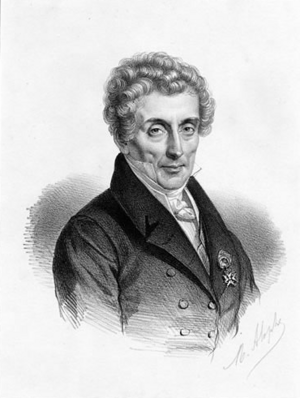
In 1822, Cherubini became the director of the Conservatoire, a famous music school. He finished his music textbook, Cours de contrepoint et de fugue, in 1835. His role at the Conservatoire sometimes led to disagreements with the young composer Hector Berlioz. Berlioz later wrote in his memoirs that Cherubini was a grumpy teacher. Some people believe Berlioz's description made Cherubini seem worse than he was. However, many people did say Cherubini could be irritable. For example, Adolphe Adam wrote that "some maintain his temper was very even, because he was always angry."
Despite this, Cherubini had many friends, including the pianist Szymanowska, Rossini, Chopin, and especially the artist Ingres. Cherubini enjoyed painting, and Ingres liked playing the violin, so they had shared interests. In 1841, Ingres painted a very famous portrait of the old composer.
Even though he didn't write a lot of chamber music (music for small groups of instruments), the pieces he did write were important. His six string quartets are considered excellent, especially numbers 1 and 3. His String Quintet (for two violins, viola, and two cellos) is also highly regarded.
During his life, Cherubini received France's highest awards. These included the Chevalier de la Légion d'honneur (Knight of the Legion of Honor) in 1814 and being named a Membre de l'Académie des Beaux-Arts (Member of the Academy of Fine Arts) in 1815. In 1841, he became a Commandeur de la Légion d'honneur, which was the first time a musician had received such a high title.
Luigi Cherubini died in Paris in 1842 at the age of 81. He is buried in Père Lachaise Cemetery, very close to his friend Chopin. His tomb has a sculpture by Augustin-Alexandre Dumont that shows "Music" placing a wreath on a bust of the composer.
Works
Orchestral Music
- Overture in G (1815)
- Symphony in D major (1815)
- Marche funèbre (Funeral March) (1820)
Chamber Music
- String Quartet No. 1 in E-flat (1814)
- String Quartet No. 2 in C (1829)
- String Quartet No. 3 in D minor (1834)
- String Quartet No. 4 in E (1835)
- String Quartet No. 5 in F (1835)
- String Quartet No. 6 in A minor (1837)
- String Quintet (2 violins, viola, 2 cellos) in E minor (1837)
Masses and Sections of the Mass
- Five masses (written 1773–1776, now lost)
- Messe solennelle brève in B-flat (1805)
- Credo a capella for eight voices and organ (1806)
- Mass in A for three voices (1809)
- Messe de Chimay in F (1809)
- Missa solemnis in D minor (1811)
- Mass (4th messe solennelle) in C (1816)
- Credo in D (1816)
- Requiem in C minor for mixed chorus (1816) in memory of Louis XVI
- Missa solemnis in E (1818)
- Mass in G (1819) for the Coronation of Louis XVIII
- Mass in B-flat (1821)
- Messe solennelle in A for the Coronation of Charles X (1825)
- Requiem in D minor for male chorus (1836) written for his own funeral
Motets and Other Choral Works
- Cantata Amphion (1786)
- Cantata Circé (premiered 1789)
- Trois chœrs: Music for the play La Mort de Mirabeau (1791)
- Cantata Clytemnestra (1794)
- Cantata Hymne au printemps ("Hymn to Spring") (1815)
- Hymne du Panthéon (1794)
- 38 motets
Operas
- See List of operas by Luigi Cherubini
Teaching Manuals
- A treatise on counterpoint and fugue (1841)
|
See also
 In Spanish: Luigi Cherubini para niños
In Spanish: Luigi Cherubini para niños


